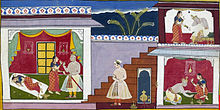Dašaratha
| Dašaratha | |
|---|---|
| Maurjovský panovník | |
 Dašaratha slibuje vyhnat Ramu na přání Kaikéjí | |
| Doba vlády | okolo 232 – 224 př. n. l. |
| Předchůdce | nejspíše Ašóka, možná Kunála nebo Sampadi (?) |
| Nástupce | Samprati |
| Dynastie | Maurjů |
| Některá data mohou pocházet z datové položky. | |
Dašaratha byl zhruba mezi lety 232 – 224 př. n. l. král Maurjovské říše. Podle Matsja purány na trůn nastoupil po svém dědovi, králi Ašókovi.[1] Podle legend však po Ašókovi nastoupil jeho syn Kunála či Kunálův syn Sampadi; určení pořadí maurjovských panovníků po Ašókovi proto zůstává nejisté.[2]
Dašaratha měl v Nágárdžunovských horách věnovat tři jeskyně ádžívikům. Podle nápisu, který nechal zhotovit Dévánámpija Dašaratha, tak prý učinil hned po svém nástupu na trůn.
Reference
Externí odkazy
 Obrázky, zvuky či videa k tématu Dašaratha na Wikimedia Commons
Obrázky, zvuky či videa k tématu Dašaratha na Wikimedia Commons
V tomto článku byl použit překlad textu z článku Dasaratha Maurya na anglické Wikipedii.
Média použitá na této stránce
"In the second book, the Book of Ayodhya (Ayodhya Kand), Kaikeyi has become jealous of Rama as his father has announced that he is to be installed as regent. In this picture, she is first seen on the left lying on the ground in a dishevelled and angry state having stripped herself of her ornaments. Dasaratha is overcome at the sight of her and promises to do anything she wants to appease her. She rises from the ground to demand that her son Bharata be promised the throne and Rama be exiled for fourteen years. Rama was less than sixteen years old at this time. On the right Dasaratha is first seen bemused seated on a couch as he listens to Kaikeyi's demands and then below kneeling at her feet beseeching her to change her mind. The action revolves around the still figure of the minister Sumantra, who makes a pictorial link with the next episode, since he is sent by the Brahmins to awaken the king to begin the consecration of Rama as regent."
